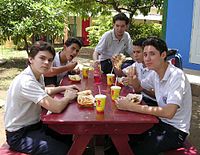
Education in Nicaragua is free for all Nicaraguans. Elementary education is free and compulsory although this is not strictly enforced. Many children are not able to attend if their families need to have them work. Communities on the Atlantic Coast have access to education in both Spanish and the languages of the native indigenous tribes that live in the more rural areas of Nicaragua. Higher education has financial, organic and administrative autonomy, according to the law. Freedom of subjects is recognized.[1] The school year runs from February through November.[2]
The Human Rights Measurement Initiative (HRMI)[3] finds that Nicaragua is fulfilling only 73.7% of what it should be fulfilling for the right to education based on the country's level of income.[4] HRMI breaks down the right to education by looking at the rights to both primary education and secondary education. While taking into consideration Nicaragua's income level, the nation is achieving 92.3% of what should be possible based on its resources (income) for primary education but only 55.1% for secondary education.[4] 82.6% of the population age 15 and over is literate, the lowest literacy rate in Central America.[5]
- ^ Nicaragua's President, Daniel Ortega Archived 2006-12-28 at the Wayback Machine to enforce free education
- ^ "School Background Info".
- ^ "Human Rights Measurement Initiative – The first global initiative to track the human rights performance of countries". humanrightsmeasurement.org. Retrieved 2022-03-26.
- ^ a b "Nicaragua - HRMI Rights Tracker". rightstracker.org. Retrieved 2022-03-26.
- ^ "Nicaragua", The World Factbook, Central Intelligence Agency, 2024-01-31, retrieved 2024-02-02
